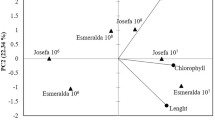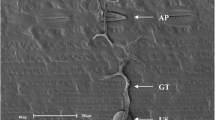Abstract
In the present study, the progression of Phomopsis azadirachtae infection in neem was evaluated using two methods namely, ergosterol estimation and qRT-PCR method. Using artificially infected neem seedlings the disease progression was tabulated at specific intervals by observing the disease symptoms, like the characteristic lesions and drying. The ergosterol method estimated a mycelial mass ranging from 0.0008–0.093 µg/g, the qRT-PCR method estimated mycelial mass ranging from 0.0008–0.099 µg/g. Both the methods indicated the progression of infection within the neem tree. In conclusion, the pathogen was exponentially high around the 20th day post infection, suggesting optimal establishment within the neem plants.



Similar content being viewed by others
References
Amend AS, Seifert KA, Bruns TD (2010) Quantifying microbial communities with pyrosequencing: does read abundance count? Mol Ecol 19:5555–5565
As’wad AWM, Sariah M, Paterson RRM, Abidin MAZ, Lima N (2011) Ergosterol analyses of oil palm seedlings and plants infected with ganoderma. Crop Prot 30:1438–1442
Baldauf SL (1999) A search for the origins of animals and fungi: comparing and combining molecular data. Am Nat 154:S178–S188
Baldrian P, Tomas V, Tomas C, Petra D, Mirka P, Jaroslav S, Ivana E (2013) Estimation of fungal biomass in forest litter and soil. Fungal Ecol 6:1–11
Corradi N, Croll D, Colard A, Kuhn G, Ehinger M, Sanders IR (2007) Gene copy number polymorphisms in an arbuscular mycorrhizal fungal population. Appl Environ Microbiol 73:366–369
Eikenes M, Hietala AM, Alfredsen G, Fossdal CG, Solheim H (2005) Comparison of quantitative real-time PCR, chitin and ergosterol assays for monitoring colonization of Trametes versicolor in birch wood. Holzforschung 59:568–573
Fukami T, Dickie IA, Paula WJ, Paulus BC, Park D, Roberts A, Buchanan PK, Allen RB (2010) Assembly history dictates ecosystem functioning: evidence from wood decomposer communities. Ecol Lett 13:675–684
Garber RC, Turgeon BG, Selker EU, Yoder OC (1988) Organization of ribosomal RNA genes in the fungus Cochliobolus heterostrophus. Curr Genet 14:573–582
Gessner MO, Newell SY (2001) Biomass, growth rate, and production of filamentous fungi in plant litter. In: Hurst CJ, McInerney M, Stetzenbach L, Knudsen G, Walter M (eds) Manual of environmental microbiology, 2nd edn. ASM Press, Washington DC, pp 390–408 (in press)
Girish K (2007) Studies on the biology and management of Phomopsis azadirachtae the incitant of die back disease on neem Azadirachta indica A Juss. Ph.D. thesis. University of Mysore. Mysore, India
Hasegawa E, Ota Y, Hattori T, Kikuchi T (2010) Sequence-based identification of Japanese Armillaria species using the elongation factor-1 alpha gene. Mycologia 102(4):898–910
Heid CA, Stevens J, Livak KJ, Williams PM (1996) Real time quantitative PCR. Genome Methods 6:986–994
Henson JM, French R (1993) The polymerase chain reaction and plant disease diagnosis. Annu Rev Phytopathol 31:81–109
Hogberg MN (2006) Discrepancies between ergosterol and the phospholipid fatty acid 18:2ω6,9 as biomarkers for fungi in boreal forest soils. Soil Biol Biochem 38:3431–3435
Maleszka R, Clark-Walker GD (1990) Magnification of the rDNA cluster in Kluyveromyces lactis. Mol Gen Genet 223:342–344
Manter DK, Kelsey RG, Stone JK (2001) Quantification of Phaeocryptopus gaeumannii colonization in Douglas-fir needles by ergosterol analysis. For Pathol 31:229–240
McCartney HA, Foster SJ, Fraaije BA, Ward E (2003) Molecular diagnostics for fungal plant pathogens. Pest Manag Sci 59(2):129–142
Michael A, Sambasivam KP, Angela F, Ian D, Ulrike S, Evans L, Anthony P (2014) Simple quantification of in planta fungal biomass. Plant Pathog Interact 1127:159–172
Min Q, Yinong Y (2002) Quantification of Magnaporthe grisea during infection of rice plants using real-time polymerase chain reaction and northern blot/phosphoimaging analyses. Phytopathology 92(8):870–876
Mohamadhasan T, Mojtaba P, Shaghayegh HJ (2014) Comparison of SYBR Green and TaqMan methods in quantitative real-time polymerase chain reaction analysis of four adenosine receptor subtypes. Adv Biomed Res 28(3):85
Montgomery HJ, Monreal CM, Young JC, Seifert KA (2000) Determination of soil fungal biomass from soil ergosterol analyses. Soil Biol Biochem 32:1207–1217
Muniroh MS, Sariaha M, Zainal AMA, Lima N, Paterson RRM (2014) Rapid detection of Ganoderma-infected oil palms by microwave ergosterol extraction with HPLC and TLC. J Microbiol Methods 100:143–147
Nagendra PMN (2009) Investigations on epidemiology and management of Phomopsis azadirachtae—the causative agent of die-back disease of neem. Ph.D. thesis. University of Mysore. Mysore, India
Nagendra PMN, Bhat SS, Charith RAP, Janardhana GR (2006) Molecular detection of Phomopsis azadirachtae, the causative agent of dieback disease of neem by polymerase chain reaction. Curr Sci 91:158–159
Ng HE, Raj SSA, Wong SH, Tey D, Tan HM (2007) Estimation of fungal growth using the ergosterol assay: a rapid tool in assessing the microbiological status of grains and feeds. Lett Appl Microbiol 46:113–118
Niemenmaa O, Uusi-Rauva A, Hatakka A (2007) Demethoxylation of [O14CH3]-labelled lignin model compounds by the brown-rot fungi Gloeophyllum trabeum and Poria (Postia) placenta. Biodegradation 19(4):555–565
Nylund J-E, Wallander H (1992) Ergosterol analysis as a means of quantifying mycorrhizal biomass. Methods Microbiol 24:77–88
Osswald WF, Holl W, Elstner EF (1986) Ergosterol as a biochemical indicator of fungal infection in spruce and fir needles from different sources. Microb Ecol 41(5–6):542–546
Prithvi SS, Ramith R, Adkar CRP, Nagendra PMN (2015a) Development of a simple and reliable species-specific detection of Phomopsis azadirachtae, using the translation elongation factor 1-alpha gene. Eur J Plant Pathol 141(4):769–778
Prithvi SS, Ramith R, Dhananjaya BL, Nagendra PMN (2015b) In vitro inhibitory activity of medicinal plants against Phomopsis azadirachtae, the incitant die back disease of neem. Int J Pharm Pharm Sci 7(4):43–49
Robert OB, Terry AT (2013) Field and laboratory guide to tree pathology. Academic Press, Cambridge, London, pp 9–13
Ruzicka S, Edgerton D, Norman M, Hill T (2000) The utility of ergosterol as a bioindicator of fungi in temperate soils. Soil Biol Biochem 32:989–1005
Sateesh MK (1998) Microbiological investigations on die-back disease of neem (Azadirachta indica A. Juss.). Ph.D. thesis. University of Mysore. Mysore, India
Seitz L, Mohr H, Burroughs R, Sauer D (1977) Ergosterol as an indicator of fungal invasion in grains. Cereal Chem 54:1207–1217
Tetyana T, Daniel R, Simone P (2013) A new multi locus approach for a reliable DNA-based identification of Armillaria species. Mycologia 105:1059–1076
Timothy YJ, Frank K, Conrad LS et al (2006) Reconstructing the early evolution of fungi using a six-gene phylogeny. Nature 443:818–822
Udayanga D, Castlebury LA, Rossman AYR, Hyde KD (2014) Species limits in Diaporthe: molecular re-assessment of D. citri, D. cytosporella, D. foeniculina and D. rudis. Persoonia 32:83–101
Wallander H, Ekblad A, Godbold DL, Johnson D, Bahr A et al (2013) Evaluation of methods to estimate production, biomass and turnover of ectomycorrhizal mycelium in forests soils—a review. Soil Biol Biochem 57:1034–1047
Xin T, Malcolm W, Michael OS, Ma D (2001) World distribution and trade in neem products with reference to their potential in China. In: Conference paper in Australian Agricultural and Resource Economics Society (AARES), Adelaide
Zewei S, AndrewV Sadowsky MJ, Jonathan SS (2014) Quantitative PCR for measuring biomass of decomposer fungi in planta. Fungal Ecol 7(1):39–46
Acknowledgements
All authors thank the Principal SJCE, Mysore for his support and encouragement throughout the execution of this work. The authors also thank the President and Secretary of SDME Society, Ujire for their encouragement.
Funding
Prithvi S. Shirahatti thank The Department of Science and Technology, Science and Engineering Research Board, New Delhi, India for awarding the Research fellowship.
Author information
Authors and Affiliations
Corresponding author
Electronic supplementary material
Rights and permissions
About this article
Cite this article
Shirahatti, P.S., Ramu, R., Swamy, S.N. et al. Monitoring progression of the die back pathogen Phomopsis azadirachtae in neem seedlings. Indian Phytopathology 72, 139–146 (2019). https://doi.org/10.1007/s42360-018-0099-7
Received:
Revised:
Accepted:
Published:
Issue Date:
DOI: https://doi.org/10.1007/s42360-018-0099-7





